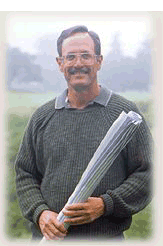 |
|---|
|
|||||||||||||||||
|
|||||||||||||||||
|
|||||||||||||||||
|
|||||||||||||||||
|
|||||||||||||||||
|
|||||||||||||||||
|
|||||||||||||||||
|
|||||||||||||||||
|
|||||||||||||||||
In Search for a Game by
Donald Knott How about a game? Of course! We'll play the championship course near by, the one that's 7100 yards, par 72, and ranked the toughest in the area. Why not! From the back no doubt. Sure such a course can be great fun, but are Americans becoming too narrowly focused on what they consider an acceptable venue for the game? There are many well discussed issues in golf today, not the least of which is accessibility and affordability. But perhaps larger than any of the day to day issues is what I perceive to be a narrowing myopic view of the game and particularly the golf course. The parameters of an "acceptable" golf course continue to become more rigid and narrowly focused. It is time all of us, and particularly golf course architects resist this myopic vision of the course and expand the envelope of accepted standards. Why is it that the standards of a great course must be (a) 7,000 plus yards in length, (b) must be a par of 72 with two par 3's and two par 5's, (c) must have returning nines, (d) must have fairways that provide perfect lies, (e) must have fairways that are clearly visible and well "defined", (f) must have greens that are puttable and "fair" at some arbitrary reading on a stimp meter, (g) must have small greens for short holes and large greens for long holes, (h) must have trees on all sides of each hole, (i) must have greens that are visible from the fairway, (j) must be considered "fair" by the score oriented professional, (k) etc., etc., etc., ... in a continuously growing list of arbitrary standards that push us further from the origins and the very essence of the game? What happened to the original concept of the game? The game started as an obstacle course, played over natural terrain. It was the player's option to choose a route and strategy to get from point A to point B. There were random obstacles and no "path". Even today there is no such thing as "fairway" in the rules of the game. Our modern day courses are looking much more like a bowling alley, with narrow strips of "fairway" flanked by the occasional hazard near the "defined" landing area. One only need play several of the ancient links courses to realize how exciting and fun this game can be, and what the origins of the game we intended to be. These ancient links courses have withstood the test of time because they continue to fascinate; because they continue to emulate life itself. These courses, like life, present obstacles and hazards. Some are visible and allow one to formulate a strategy in an attempt to avoid them. Some obstacles are not visible and present themselves at random. What often appears as the most direct route to your objective is often not as easy as envisioned. Such unexpected events are dealt with to the best of our ability at the time they present themselves. Some routes appear safe from a distance but later present such subtle complications that one doesn't fully understand until completely entangled. Some hazards appear difficult, but prove to be playable. Others that look safe prove to be disaster. Some hazards, as in life, are inescapable. Random luck is always a factor. A golf course should not be "defined" with a clear path to one's goal. Such is not real life or real golf. Some shots must be played on intuition and faith. Without some mystery and without significant obstacles, the golf course would have no appeal. The concept of a defined "fairway" to one's destination may sound appealing, but in the long run will never hold the fascination, excitement, mystery and enjoyment of the game played as an obstacle course through nature. We cannot reduce the golf course to a standard predictable venue. A great course must always call for courage, skill, strategy, self-control, a test of temper and a revealer of character. Let us not reduce the game to simply a test of swing execution. If swing execution is the ultimate examination, we need only construct high tech driving ranges. Golf and a golf course must be far more than a theater to perfect execution. A golf course must, like life, offer problem solving, intrigue, mystery, the ability to be creative, the opportunity to experiment, challenge your limits and test your character. I realize there are numerous combined forces and trends that seem to constantly narrow the concept of the golf course: The concept of par itself (which was not part of the game's origin); the real estate dominated economics which create forces to minimize space and maximize frontage; the score oriented professional players that dominate the golf press and public opinion; the USGA setup of the Open; the modern day course rating systems with consensus building structures and more. All of these contribute directly to a narrower definition of the "acceptable" golf course. These are strong forces and difficult to alter. Nevertheless, I believe it is time to push for an expanded concept of what golf should and could be. Why, for example must a course be 18 holes? The game did not start that way. Any number of holes was acceptable for hundreds of years. Just imagine the number of new facilities that could be available if golfers accepted the concept of a 6, 11, or 15 hole course. If availability and speed of play are real issues, then let's reconsider our myopic view of the golf course and of the game. GOLF
is a : |
||
Copyright © 2000-2008
Knott & Linn Golf Design Group, LLC
All Rights Reserved
Photography
Courtesy of John & Jeannine Henebry
This website created by
JustImagineDesign.com
